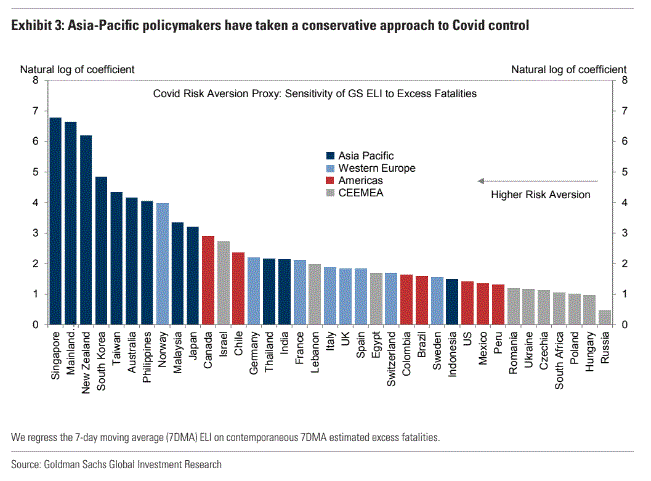Goldman with the note. Slowly but surely they’re all falling in behind the MB view of China:
China has been back in focus over the past month with a notable pickup in policy and market volatility. Ongoing regulatory pressures—reflecting a broadening of efforts beyond financial risk reduction to include concerns over anticompetitive behavior, data security, and social inequality—came to a head with a crackdown on the after-school tutoring sector that sharply reduced the scope for private companies to operate, along with their equity values. While authorities had previously signaled concern about this space, the severity of the action was unexpected and has prompted many investors to reassess regulatory risk, particularly for offshore-listed equities (Exhibit 1). Separately, the property sector continues to be under strain given the ongoing debt servicing pressures on Evergrande, one of the country’s largest property developers (Exhibit 2). Government bond yields have also moved lower, with the 10-year CGB yield down about 25bp in the past month. As we warned previously, the various sector-level regulatory tightenings don’t look too threatening to growth in isolation, but collectively they could be material.

Several downside risks exist for China’s second-half growth outlook, some long-anticipated and some new. First, the latest high-frequency growth data suggest deceleration, with the three July PMIs released so far (both official PMIs and the Markit manufacturing PMI) all lower, though still north of 50. The “new export orders” index of the official manufacturing PMI slid to 47.7, a post-lockdown low, seemingly validating prior concerns about H2 deceleration in export growth. Second, Covid risks have increased materially, with a daily total of nearly 100 cases across 14 of China’s provinces on August 1 following a recent outbreak traced to Nanjing airport, prompting multiple local and regional control measures (our Effective Lockdown Index has already returned to its tightest level since February). While China’s track record suggests the outbreak will likely be brought under control in coming weeks, the question is at what economic cost. Third, policymakers still appear reluctant to implement significant macro policy easing, with Friday’s Politburo meeting maintaining a broadly neutral tone—with a tight stance on property policies and a hint that fiscal support could be more backloaded than we had assumed. To the extent policymakers are concerned about growth, our sense is that their focus is on year-over-year figures, in which case the bar for Q3 is still relatively low (we currently forecast real GDP growth of just over 6% yoy in Q3, but expect growth to fall to 4.6% yoy in Q4).


